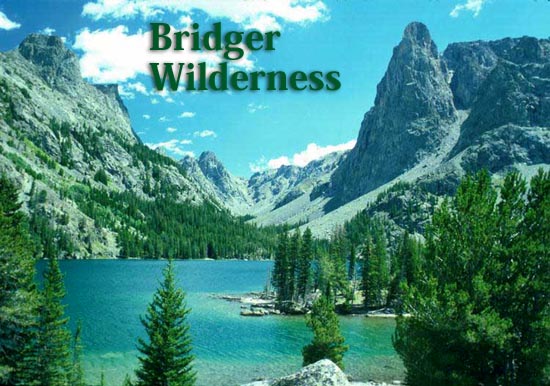 |
Jim
Bridger
|
 |
Jim
Bridger
|
Bridger
Wilderness
|
Bridger Wilderness At-a-Glance Size: 428,169 acres |
About the Bridger Wilderness
Wilderness and You
Required Registration & Permits
Wilderness Regulations
Wilderness Safety
Allowed Uses
The 428,169-acre Bridger Wilderness is located along the Continental Divide on the west slope of the Wind River Range in Wyoming. It was designated a Primitive Area under Department of Agriculture Regulations in 1931, and later made part of the National Wilderness Preservation System with passage of the Wilderness Act in 1964. In 1984, its original 392,169 acres were increased by 36,000 acres when the Wyoming Wilderness Act was signed into law. The Bridger Wilderness is administered by the Pinedale Ranger District of the Bridger-Teton National Forest.
Motorized vehicles and mechanized equipment, including snowmobiles, bicycles, hang gliders and chainsaws, are prohibited within the Bridger Wilderness.
Wilderness, as defined by the Wilderness Act of 1964, is an area of undeveloped federally owned land, designated by Congress, that has the following characteristics:
Topography
The intricately faulted Wind River Range is dominated by an
igneous and metamorphic core. Enormous
compressional forces in the earth thrust the block of granite into the
air. The glaciation and erosion that followed carved the range, leaving
13,804 foot Gannet Peak the highest mountain in the Wilderness and in
Wyoming.
Glacial action left cirques, kettles, U-shaped valleys, hanging troughs, 1,300 lakes, and left "erratics", boulders strewn about the lowlands. The sedimentary rocks that once overlay the granitic core of the range have been stripped from the mountains by erosion. Remnants of the sedimentary rocks remain near Green River Lakes.
The Wind River Mountain Range has seven of the ten largest glaciers remaining in the contiguous United States. The Green River originates in the Bridger Wilderness. The Green River joins the Colorado after 1,500 miles and empties into the Gulf of California. The Green River drains most of the west side of the Wind River Range. The Sweetwater River drains the southern end of the range and flows into the Platte River and ultimately the Gulf of Mexico.
Access
US Highway 191, the major highway between Rock Springs and
Jackson, Wyoming, lies west of the Wind River Range. Trailheads are reached
via roads which are clearly signed at intersections with Highway 191.
Both Jackson and Rock Springs have commercial air and bus lines. Pinedale
has a paved, non-commercial public airstrip located about 6 miles south
of town. Shuttle services between Jackson and Rock Springs, and trailheads,
are available from local private businesses.
Trails
There are over 600 miles of trails in the Bridger Wilderness.
Most well-used trails are cleared early in the season, but fallen trees
may be encountered on secondary trails. Winter snows generally do not
leave the high passes and highest trails until mid-July. Stream flows
are high and swift during snowmelt runoff in June and July, and some
stream crossings can be hazardous. Check at the Pinedale Ranger Station
Office, or call them at 307-367-4326, before beginning your Wilderness
trip. Books with detailed trail descriptions are available at local sporting
good stores and bookstores.
Weather
The weather is usually warm and sunny during the day from
June through September, with afternoon thunderstorms being common. Night
temperatures may be as low as 25 degrees Fahrenheit. Sudden rain and
occasional snow flurries may occur at ANY TIME. During lightning storms
it is best to avoid open areas such as meadows, ridges, lone trees, and
mountain tops. Find safer shelter in dense stands of trees or boulder
fields.
Insects
Mosquitoes, deerflies and horseflies are plentiful most of
the summer, making insect repellent a must.
Wildlife
The Bridger Wilderness contains a rich diversity of wildlife
species, including large mammals such as moose, elk, bighorn sheep, mule
deer, bears (black & grizzly-see Bears and You for
more information), yellowbellied marmots and beaver. Birds that are common
include the Canada ('gray') jay, Clark's Nutcracker and raven. These
birds frequently show up around camp when there is food around. The high
meadows are home to water pipits, rosy finches and mountain blackbirds.
The dipper may be seen in fast-moving mountain streams standing on streamside
rocks, bowing and bobbing, until it decades to plunge into the icy water
for insects. Historically, the Bridger Wilderness had no fish in most
of its lakes. Stocking programs during the 1920's and 1930's were successful,
and today grayling, mountain whitefish and six trout species can be found.
Recreation
Backpacking is the primary activity of people who visit the
Bridger Wilderness, and many trails provide access to the area. There
are also areas without trails for those who wish more solitude. Other
activities include hiking, horseback riding and packing, mountain climbing,
mountaineering, and wilderness camping. Please
note: Motor vehicles, including snowmobiles, bicycles and hang gliders,
are prohibited within the Bridger Wilderness.
Water
The water in the Bridger Wilderness looks clean and pure,
but take care. Waters
throughout the country contain a variety of organisms, some of which
can make you very sick. The parasite Giardia, an organism present as
a cyst in the feces of infected animals and humans, is most commonly
spread through water. Other microbes, including Campylobacter, may also
be around, and can upset your stomach and intestinal tract.
Giardia: If you wish to treat your water for Giardia, boil it for one minute, or use a filter with a pore size less than one half micron.
Campylobacter: Requires boiling for five minutes or filtering.
Iodine water treatments may work if the directions are followed carefully. The effectiveness of iodine treatment is dependent on the type of iodine, freshness, exposure time, and temperature, purity and pH of the water being treated. Chlorine treatments are not recommended.
Another option for short trips: Bring your water with you.
Maps
Topographic maps, trail maps, Wilderness maps, campground
and recreation facility maps, and other useful guides are available locally
in Pinedale at sporting goods stores. Additional information is also
available at the Pinedale Ranger District and BLM Offices.
Camping
Select a campsite away from lakes, streams and other camps to preserve
a feeling of privacy and solitude. Your campsite should be out of sight
of trails and water bodies, or, where screening is not provided by vegetation
or topography, a minimum of 200 feet from lakes or trails. Constant use
of the same campsites leaves permanent scars. Soils become compacted
and plant life is crushed and worn away. Campfire ashes accumulate and
the area becomes visibly worn. If you use an existing campsite, leave
it in better condition than you found it. Or, be a no-trace pioneer and
select an unused campsite away from heavily used areas. Leave it natural!
Select subdued colors for clothing and equipment. Browns and greens are
best. Bright colors have a greater visual impact on the privacy and solitude
of others.
Campfires
Campfires are permitted in the Bridger Wilderness with the exception
of seven "special management areas". Lightweight gas stoves
are more efficient and faster for cooking than fires, and they leave
no impact. Campfires destroy organic matter in the topsoil and may inhibit
plant growth for many years. Blackened rocks, charred wood, and accumulated
ash also alter the natural appearance of the site.
If a campfire is used, here are suggestions to minimize impact:
Campfires are allowed below timberline using only down materials. Do not cut firewood from standing or live trees.
Firewood
Trees grow slowly at high altitude and fires consume wood which would
otherwise decompose and replenish the soil with nutrients. Particularly
in areas where trees are stunted and scarce, gathering firewood has a
severe impact on vegetation. Burn dead and down wood and only that which
is necessary. Standing dead and gnarled snags are components of the wilderness
scenery and important habitat for cavity-nesting birds and many small
mammals.
Sanitation
Bury human waste in a shallow hole at least 100 feet from any water
supply, so that rain or snow runoff will not carry contaminants to lakes
and streams. Studies have shown that decomposition of waste is best in
holes dug 6-8 inches deep. Soap (even biodegradable brands) and food
particles pollute lakes and streams. Please wash your dishes, clothes
and yourself well away from shore. Carry out cans, bottles, plastics,
aluminum foil and anything else that will not burn. Burying doesn't work.
If frost action doesn't heave your buried garbage to the surface, animals
will dig it up.
Please, if you pack it in, pack it out!
Pets
Pets occasionally bother other visitors, wildlife and grazing livestock.
Please keep your pets under control at all times and away from other
people.
Trail Etiquette
Wilderness trails are constructed and maintained to minimize impact
of human use. Short-cutting switchbacks and cutting across meadows damage
plant life and cause soil erosion. Please use trails where provided.
Hikers meeting horse parties on the trail should move a considerable
distance off the trail and remain quiet and motionless until the horses
pass, unless advised otherwise by the riders. Bright-colored gear, bulky
packs, and sudden noise or movement may cause a horse to spook, resulting
in general chaos, and injury to horses, riders and hikers. Curious pets
can also cause a problem. It is advisable that pets be held until the
horses pass.
Please use the trails where provided.
Registration at the Ranger Station or Campgrounds is not necessary. Registration boxes are provided at all major trailheads, and visitors are asked to please register at these stations, and to add your comments and suggestions. Registers are used as a management tool by the Forest Service to provide essential information on visitor use and preference. This information helps Wilderness managers meet the needs of visitors and minimize impacts to the wild setting.
Permits
Permits are required for the following:
Group Use
All organized groups (clubs, schools, church groups, scouts, etc.)
are required to obtain a permit from the Pinedale Ranger District, PO
Box 220, Pinedale, WY 82941, 307-367-4326. There is no charge for these
permits as long as the groups are not commercial. You will need to provide
the following information:
Stock Use
All overnight parties using horses within the Wilderness are required
to obtain a permit from the Pinedale Ranger District Office. Permits
are not required for day rides, unless commercial. The maximum permitted
number of stock is 25 head per party.
Commercial Use
Commercial Outfitters operate under Special Use Permits for which
a fee is paid. They are licensed by the State of Wyoming, and their operations
are permitted by the Pinedale Ranger District. Contact the District Office
for information about licensed Outfitters who operate in the Bridger
Wilderness and the services they provide.
The purpose of these regulations is to assure protection and quality of the wilderness resources as well as the safety of the wilderness visitor. Violation of regulations is punishable by fine and/or imprisonment. The following acts ate PROHIBITED within the Bridger Wilderness:
Pack and saddle stock will be tied so as not to cause injury or damage to any tree, vegetation or soil.
Party size is restricted to 15 people and 25 pack and saddle stock.
Non-burnable garbage will be packed out, not buried.
Bulk hay or straw is not permitted.
Camp structures such as hitch racks, tent frames, pegs and fire rings will be dismantled after use.
Wilderness has many potential dangers, which are part of the Wilderness experience. You must be prepared to take care of yourself. As a general precaution, it is wise to travel with another person and to tell a friend where you plan to be, and when you plan to return. Here are some other safety suggestions:
Livestock Grazing
Livestock grazing is permitted where such use was established before
the wilderness was designated. Livestock grazing is administered under
allotment management plans. Sheep graze the Bridger Wilderness from July
to September. Herding practices are designed to minimize contact with
recreationists. Brief encounters may occur in meadows from Cooks Lake
south to the Sweetwater River. Cattle graze some of the western fringes
of the Wilderness. Motorized use may be permitted in maintaining facilities
or managing grazing allotments if no other reasonable alternative is
available.
Mining
Mining operations on valid or patented claims are permitted indefinitely.
Permitted mining operations in the Temple Creek/Schlestler Peak area,
near Big Sandy Trailhead, involve occasional use of motor vehicles and
equipment.
Hunting and Fishing
Hunting and fishing is allowed under state laws with a valid Wyoming
hunting or fishing license. Licenses and regulations can be obtained
from the Game and Fish Department, State of Wyoming, Cheyenne Wyoming
82002, or any appointed licensing agent throughout the state.
Commercial Service
Commercial services that facilitate enjoyment of the Wilderness are
allowed. Commercial services are administered under special use permits.
Outfitter camp permits may allow tent frames, hitch rails and corrals
of natural materials at approved locations. These facilities may be left
standing for brief periods between trips, but are normally dismantled
at the end of the permitted season.
For more area information:
Pinedale Ranger District
Bridger-Teton National Forest
29 E Fremont Lake Road
PO Box 220
Pinedale, WY 82941
Phone: 307-367-4326
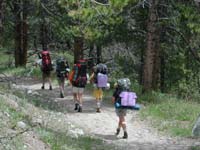
Wilderness
access trail at Green River Lakes
"Camps must be more than 200 feet from any lake or trail system and 100 feet from any stream in the Bridger Wilderness."
"Motorized vehicles are prohibited in the Bridger Wilderness, including bicycles, snowmobiles, carts and chainsaws."
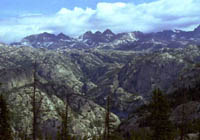
View from Photographer's Point
"Organized groups such as Scouts, church groups, clubs, school groups must have a visitor permit, which is free."
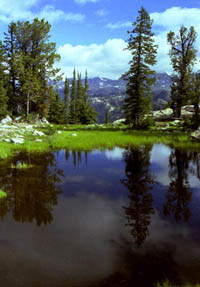
Pond near Photographer's Point
"Group size is limited to 15 people and 25 pack and saddle stock."
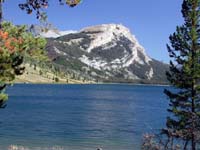
Green River Lake and White Rock Mountain
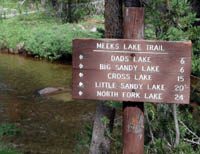
Meeks Lake Trail Sign near Big Sandy
"The maximum length of stay is 16 days in any one campsite."
Useful Local Links:
Outdoor
& Sporting Goods
Outfitters & Guides
Lodging
| To
contact Pinedale Online, call 307-360-7689, e-mail: support@pinedaleonline.com,
or stop by our office located in Office Outlet in Pinedale, 43 S. Sublette Ave.
Copyright 2021, all rights reserved. Photos by the Pinedale Ranger District
as
credited. Other photos by Pinedale
Online. May not be used without permission. | |